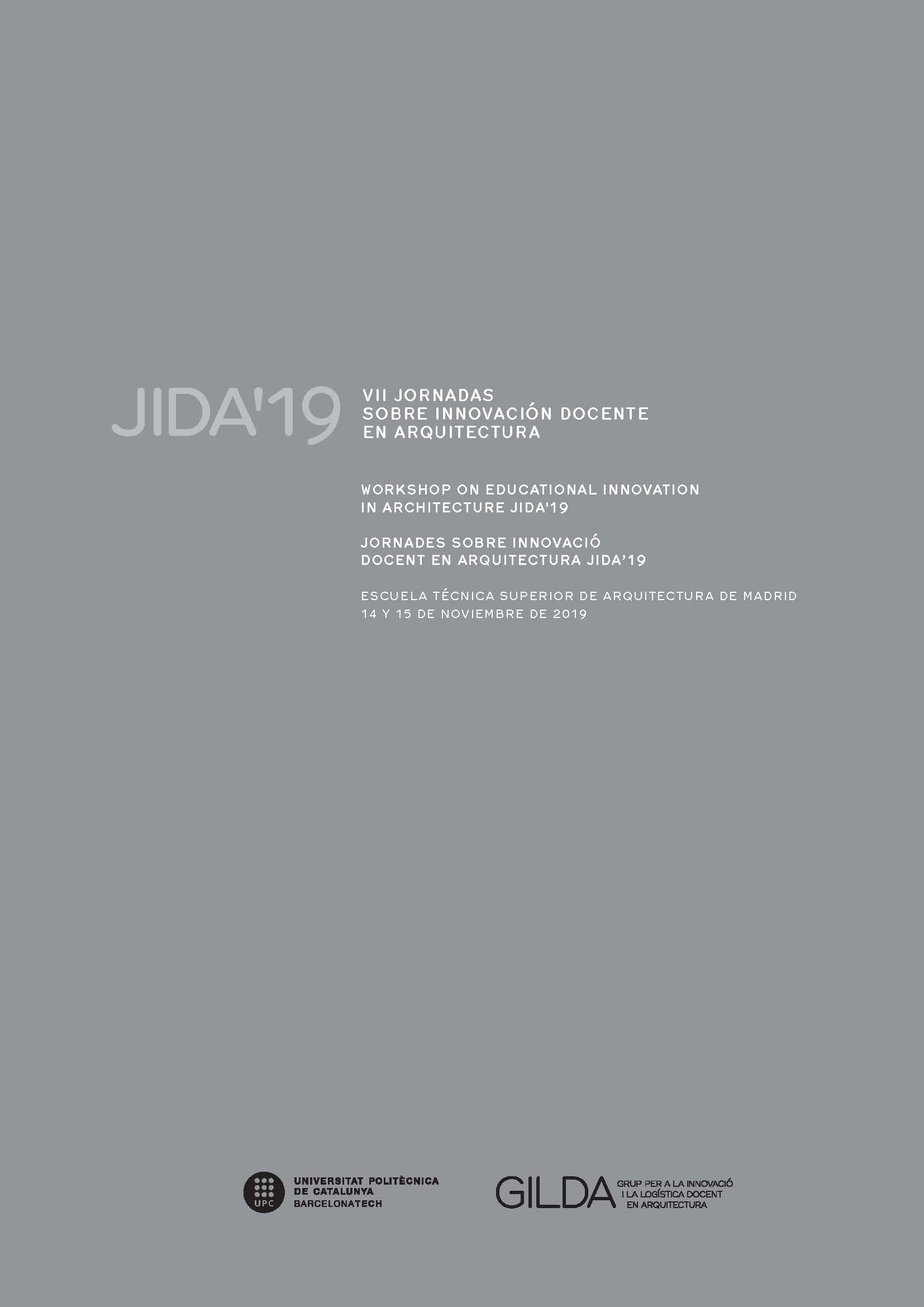Regletas urbanas. Moldear las estructuras del orden abierto
DOI:
https://doi.org/10.5821/jida.2019.8296Resumen
Una de las competencias básicas confiadas a las primeras asignaturas de urbanismo de las Escuelas de Arquitectura, son aquellas centradas en la capacidad de configurar espacios urbanos que satisfagan las exigencias estéticas y técnicas. En esta línea, ofrecemos los resultados obtenidos a partir de la aplicación de una metodología activa de aprendizaje con cierto grado de gamificación, centrada en aprender a componer espacios urbanos a partir del uso de “regletas” configurando pequeñas maquetas evolutivas y calculando los parámetros básicos de scada diseño. Los resultados obtenidos en esta experiencia han sido muy positivos, destacando el aumento de la concentración, Incremento de la motivación, mayor colaboración entre pares y profesores y procesos de comparación permitiendo nivelar los resultados.
Citas
ALONSO DE ARMIÑO, L. y PÉREZ IGUALADA, J. (1988). Análisis de unidades residenciales (VI-II). Valencia. Servicio de Publicaciones UPV.
ARMSTRONG, R.H.R. y HOBSON, M. (1973). ALEA local government gaming simulation exercise. London, England: Open University Press.
BRAME, C. (2013). Flipping the classroom. Vanderbilt University Center for Teaching. Disponible en: <http://cft.vanderbilt.edu/guides-sub-pages/flipping-theclassroom/>
COPPARD. L.C. y GOODMAN, F.L. (1977). Urban Gaming/Simulation, 77. Universidad de Michigan.
CHACÓN, P. (2008). El Juego Didáctico como estrategia de enseñanza y aprendizaje. ¿Cómo crearlo en el aula? Nueva Aula Abierta nº 16. Disponible en: <http://www.grupodidactico2001.com/PaulaChacon.pdf>
CHANG, J.H. y YEH, T.L. (2015). “The influence of parent-child toys and time of playing together on attachmentâ€. Procedia Manufacturing 3, 4921-4926 Copenhagen CleanTech Cluster. 2012. “Danish Smart Cities: Sustainable living in an urban world.†In Copenhagen Capacity: Copenhagen, edited by J. Mortensen, F. Rohde, K. Kristiansen, M. Kanstrup-Clausen, and M. Lubanski. Accessed 4 October 2014.
DUKE, R.D. (1964). Gaming-simulation in urban research. East Lansing: Michigan State University Press.
ELABD, A.; y HALLOWELL, G. (2015). “Using Simulation Tools in Architectural Education: An Approach to Teaching Islamic Vernacular Urbanismâ€, in International Journal of Sustainability Education, 10, Issue 3-4, p.1-10.
FELDT, A.G. (1964). The Cornell land Use Game, Center for Housing and Environmental Studies, New York. Cornell University.
GAETE-QUEZADA, R.A. (2011). El juego de roles como estrategia de evaluación de aprendizajes universitarios. Educación y Educadores, 14(2), 289-307
KOROBAR, V. y SILJANOSKA, J. (2015). “Challenges of teaching sustainable urbanismâ€, en Energy and Buildings, 115, 121-130.
MOHINO, I., SOLÃS, E. y CORONADO, J.M. (2017). “Playing with LEGO-bricks as an innovative pedagogical tool at pre-university and university levels for teaching urbanismâ€. En Juanjo Mena, Ana GarcÃa-Valcárcel, Francisco José GarcÃa Peñalvo, Marta MartÃn del Pozo (eds.) Search and research: teacher education for contemporary contexts. Salamanca: Ediciones Universidad de Salamanca
PÉREZ IGUALADA, J. (2003). Manzanas, bloques y casas. Formas construidas y formas del suelo en la ciudad contemporánea. Valencia. Servicio de Publicaciones UPV.
PÉREZ IGUALADA, J. (2007). Elementos del proyecto urbano. Valencia. Servicio de Publicaciones UPV.
RIZZI, P. (eds.) (2016). “Simulation and Gaming in the Network Societyâ€. Translational Systems Sciences, vol 9. Springer, Singapore.
RASMUSSEN CONSULTING. (2012). “The Science Behind the Serious Play Methodâ€. Behind%20the%20LEGO%20SERIOUS%20PLAY%20Method.pdf [Google Scholar], <http://seriousplayground.squarespace.com/storage/The%20Science%20> [Consulta: 19 de agosto de 2014].
SALAMA, A. (2009). Transformative pedagogy in architecture and urbanism. Solingen. Germany. UMBAU VERLAG.
SOLÃ-MORALES, M. (1970). La Ciudad y los juegos. Barcelona. Laboratorio de Urbanismo, ETS Arquitectura.
SOSA ESPINOSA, A. et al. (2018). “El aprendizaje lúdico como estrategia didáctica: El territorio en Juegoâ€. en IV Congreso Nacional de Innovación Educativa y Docencia en Red (IN-RED 2018). Valencia, España: Editorial Universitat Politècnica de València.
STEPHENS, R. (2016). “Urban Planning Games and Simulations: From Board Games to Artificial Environmentsâ€, en Kaneda T., Kanegae H., Toyoda Y.
TAYLOR, J.L. (1971). Instructional planning systems: a gaming simulation approach to urban problems, Cambridge University Press.
UREÑA, J.M. (1979). SIMUR. Un juego de simulación urbana. Santander. Cátedra de Caminos. ETS de Ingenieros de Caminos, Canales y Puertos.
UREÑA, J.M. (1980). “El juego en el aprendizaje de la ciudad y el territorioâ€, en Ciudad y Territorio, 4-80, p. 67-76.
VENTER, C. y COETZEE, J. (2014). “Interactive Learning through gaming simulation in an integrated land use-transportation planning courseâ€, in Proffesional Issues in Engineering Education and Practice, 140, 1.






















